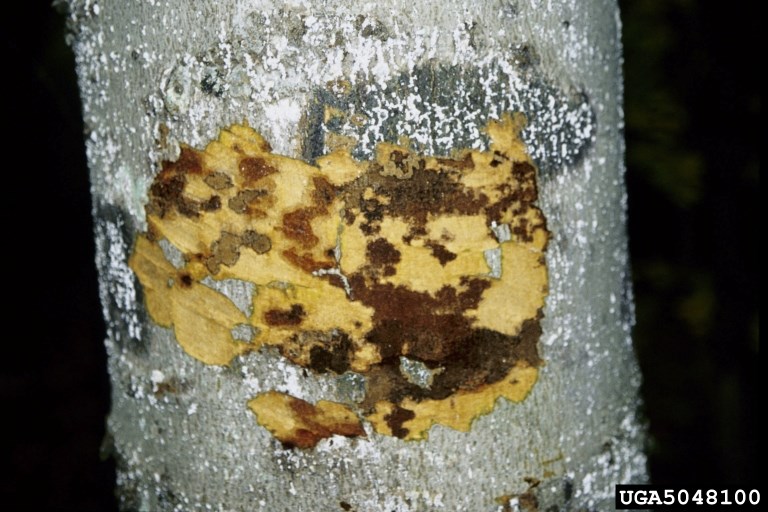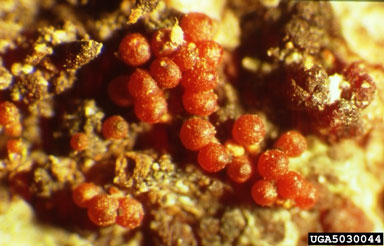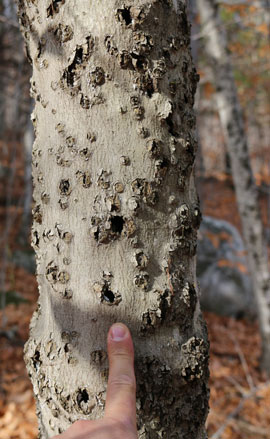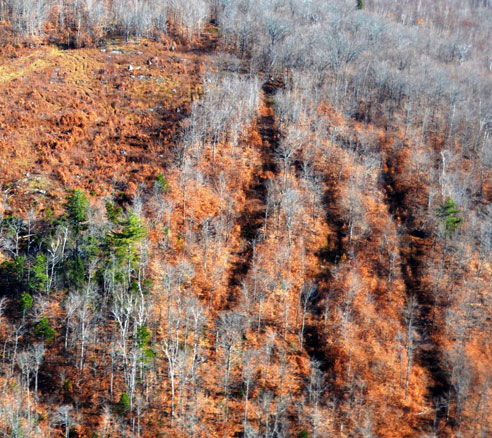DACF Home → Bureaus & Programs → Maine Forest Service →Forest Health & Monitoring → Forest Pest Index →Beech bark disease (Cryptococcus fagisuga and Neonectria spp.)
Beech bark disease (Cryptococcus fagisuga and Neonectria spp.)
Hosts:
Beech (Fagus grandifolia), European beech (Fagus sylvatica).
General information:
Beech bark disease (BBD) affects American beech trees throughout much of their natural range in North America. The disease is typically a result of the infestation and feeding by the beech bark scale, Cryptococcus fagisuga, predisposing beech trees to infection by two fungi: Neonectria coccinea var. faginta and sometimes N. galligena. Another scale, Xylococculus betulae, has been observed to be commonly associated with the disease in Maine, but its significance to the disease complex is unknown. The BBD complex arrived ca. 1920 on a shipment of infected European beech seedlings from Europe. Since its introduction, BBD has spread steadily and is now found as far west as Wisconsin. The beech scale is sedentary for most of its life. Although, after adults lay eggs in mid- to late summer, beech scale crawlers (tiny mite-like life stage of the scale) move to new feeding sites and can be transported by wind, and even wildlife, to other beech trees. As the crawlers settle into a feeding site, usually bark crevices, the scales form a waxy covering. Colonies of these scales look like white streaks or blotches on the bark (Fig.1). After feeding for some time, the scales reproduce asexually at a rate of one generation per year. Some inner-bark necrosis (death of cambium) is caused by the beech scales themselves, although most damage is due to infection by the fungal pathogen.
Symptoms and Signs:
The causal fungi enter the tree via bark wounds caused by the scale (either bark cracks from dead portions of bark drying out or actual feeding wounds). Spores are spread by wind and water (rain splash). Scattered cankers with diffuse (irregular, blotchy) margins develop. Woundwood and callus form around these areas under the bark causing a pock-marked and deformed outer appearance. As cankers spread under the bark, branch and crown dieback occur, progressively worsening and resulting in tree death. Structures of the fungi can be seen growing on the bark in either the asexual stage (cream-colored patches) or the sexual stage (clusters of small, reddish spore-producing structures called perithecia (Fig. 2).


The stages of BBD in a forest have been characterized in the following way: The scale is introduced to a new area and populations build over several years. This is called the advancing front. Next is the killing front with high populations of scale, predisposing beech trees to numerous infections by Neonectria spp.fungi present in the environment, resulting in heavy tree mortality over several years. This stage is followedby persisting populations of scale, occasional tree mortality, some residual mature trees, and some trees withvarying resistance to scale infestation. This last stage is referred to as the aftermath forest consisting ofsmall-diameter beech tree thickets that impede or prevent the establishment of other species (adapted from Shigo, 1972).
Management:
Conventional insecticide/fungicide management tools have not proven effective in controlling BBD. While high-value trees in urban settings are more easily protected, there are no practical measures available for landscape-scale management of the disease. Some resistance to beech bark scale attack, and therefore beech bark disease, has been identified among native and European beech trees, although the exact mechanism of resistance is not fully understood but is thought to be related to physical and chemical bark characteristics. Trees showing resistance should be preserved.
From a forest management perspective, areas infested with BBD represent a major challenge. The aftermath forest is characterized by a cycle of aggressive root sprouting and growth of beech saplings, followed by disease susceptibility as the trees grow, with tree death typically occurring before trees are mature enough to produce beech nuts and before the trees reach a size suitable for commercial uses.


MAINE DEPARTMENT OF AGRICULTURE, CONSERVATION AND FORESTRY
Maine Forest Service - Forest Health and Monitoring Division